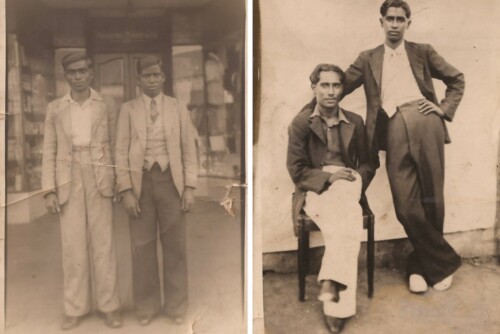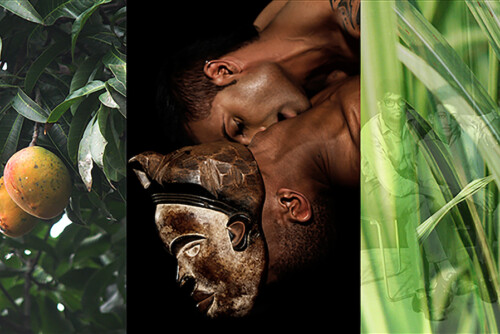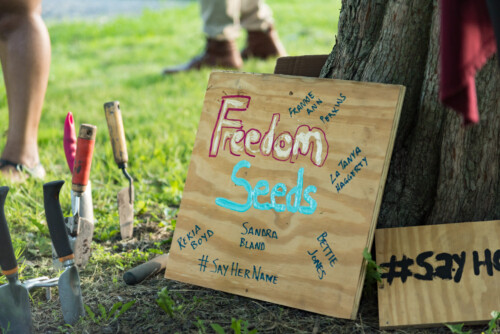Why Feminist and Queer Afro-Asian Studies Now?
Surely, this project is long overdue. But there is perhaps no better time than now for its emergence, as political movements and cultural innovations are setting examples for the shape that non-normative solidarities might take. The Black Lives Matter (BLM) movement, begun as a social media campaign by a collective of African American women and queers of color, is leading the charge of raising national and global consciousness about antiblack racial violence in America. BLM already has a critical uptake within comparative racialization projects among Asian American studies scholars and activists.1 What is less noted in mainstream characterizations of BLM is its attention to the ways that gender and sexuality “variegate” blackness.2 An intersectional approach shaped the inception of the movement, as founders Alicia Garza, Patrisse Khan-Cullors, and Opal Tometi write in their herstory of BLM:
Black liberation movements in this country have created room, space, and leadership mostly for Black heterosexual, cisgender men – leaving women, queer and transgender people, and others either out of the movement or in the background to move the work forward with little or no recognition. As a network, we have always recognized the need to center the leadership of women and queer and trans people. To maximize our movement muscle, and to be intentional about not replicating harmful practices that excluded so many in past movements for liberation, we made a commitment to placing those at the margins closer to the center.3
In a marked difference from earlier race-based movements, BLM highlights feminist and queer leaders and approaches as central to racial justice. We also see Garza, Khan-Cullors, and Tometi’s statement as providing clarity and urgency around the need to revise methodological approaches in Afro-Asian studies, which, as we have noted, largely focus on detailing the alliances forged among famous movement leaders.4 This method and model of analysis no longer holds the same relevance or import for new social movements that foreground a vision of leadership that is decentralized, horizontal, and collaborative, rather than hierarchical. Drawing on the insights and sensibilities of queer and feminist organizers of BLM, we argue that contemporary political movements demand a radical women- and queer-of-color framework for understanding the ways that Afro-Asian alliances have always been – and always will be – constituted by gender and sexuality.
In her 2008 essay “Why the Humanities Matter for Race Studies Today,” Susan Koshy frames literary and cultural analysis as primed to engage the nature of this political transformation in the twenty-first century. As we argue, cultural texts do not “reflect” a sociological “real” in representational form. Rather, they provide an imaginative and necessary repository for that which escapes recognition in the empirical realm.5 In particular, Koshy identifies the post-9/11 “shift from strategic essentialism to strategic interracialism” as demanding a turn toward the cultural.6 Whereas strategic essentialism defined group identities for political interests, strategic interracialism attends to impermanent cross-racial solidarities that continually evolve and reform in relationship to the historical present. In mapping this shift, Koshy references both the post-1965 redistribution of wealth among racial groups in the United States that disrupted “the structural divide between racial minorities and whites,” and the national security imperatives of the aughts and beyond.7 Our new political reality, she argues, no longer “readily conform[s] to the models of oppositional racial politics produced in the 1960s” around a centralized consolidation of white power.7
Contemporary women of color feminism and queer cultural production in the United States speak to this new political reality. From the Crunk Feminist Collective to the HBO-acquired series Brown Girls, Afro-Asian queer and feminist cultural forms highlight different models in which feminists and queers of color name and strategize cross-racial affiliations. Begun as a blog in 2010, the Crunk Feminist Collective is comprised of a multiracial collective of scholars who came of age in the hip hop generation of the 1990s and who gather under an overt nod to black popular culture: crunk. Here, the cultural referent of the “hip hop generation” signals a generational commonality that cuts across race and class lines, while “crunk” calls up percussion-based Dirty South rap in order to convey an irreverent and untame feminist-of-color consciousness. This form of political consciousness displaces an ethos of racialized and gendered respectability and propriety that has gained traction within identity-based political movements as a way to imbue socially marginalized subjects with value so that they may be deemed worthy of state protection and social equality. Modeling deviance as an intersectional feminist approach that challenges the conventions of both liberal feminist and academic politics, the group’s mission statement reads: “Crunk feminists don’t take no mess from nobody!”8
Brown Girls shares the Crunk Feminist Collective’s ethos of feminist defiance, but it routes this defiance through a “strategic interracialism” that takes shape via the affective structure of friendship between women who choose to remain uncoupled. The show is based on a grant-funded web series launched in early 2017 by Pakistani American Muslim poet and screenwriter Fatimah Asghar and the show’s African American director Sam Q. Bailey.9 Inspired by the pair’s real-life friendship, the show tracks the ups and downs of the work and love lives of a queer Pakistani Muslim woman and her sex-positive African American best friend. The show’s seemingly simple title points to the complicated reconsolidation of race vis-a-vis “brownness” that followed the intensified surveillance, detention, and deportation of Muslim, South Asian, and Arab religious communities after 9/11. Asian American and Arab American studies scholars have taken pains to historicize the political identity of the “Muslim terrorist” as not a “new” twenty-first century phenomenon but, instead, one that has evolved since the late twentieth century.10 Yet scholars also note the ways in which the hypervisibility of the racialized Muslim post-9/11 has brought this identity into conversation with a more historically entrenched criminalized U.S. blackness.11 Whereas it would be difficult to imagine the racial signifier “black” as hailing a South Asian, Muslim, or Arab subject post-9/11, both movements for racial justice and quotidian cultural politics now recognize and exploit the logic of racial commensurability that are at work in Islamophobic practices of state surveillance. In other words, “brown” is now a potentially politically unifying racial signifier: it names a critical outsider subjectivity, such that it may hail the African American woman as much as her South Asian counterpart.12
This more recent racial formation of brownness recalls the strikingly different cross-racial alliances forged among working-class South Asian, African, and Caribbean diasporic women in late twentieth-century Britain – there under the racial signifier “black” and known as the Southall Black Sisters.13 Where Koshy points us to the provisional multiracial formations with which we must now contend, Brown Girls reveals the way racial signifiers themselves are shifting and provisional across space and time, such that “brown” now names a queered solidarity between Muslim and black women. As the show and the Crunk Feminist Collective blog show, Afro-Asian feminist and queer solidarities are already a visible and inextricable part of our lives. So how can we make these solidarities more legible within Afro-Asian studies?
The Temporality of Queer and Feminist Afro-Asian Studies
Earlier, we described the limitations of historical methodology, which tracks cross-racial alliances by relying on institutionally archived personal correspondences or public records. Relatedly, because historical methodology privileges synchronic time, Afro-Asian studies scholars tend to focus on cross-racial alliances that occur contemporaneously, within particular periodizations of anti-colonial and anti-capitalist resistance. This approach centers on the revelation of shared oppositional consciousness among Asian and African leaders and movements. By contrast, we find that a queer and feminist approach to Afro-Asian studies is often invested in a different logic of temporality. Recently, feminist and queer scholars have been theorizing new approaches to temporality, from Elizabeth Freeman’s notion of “slow time”14 to Tina Campt’s analysis of the “grammar of anteriority” that comprises black feminist futurity.15 Within comparative Afro-Asian studies, in particular, feminist and queer scholars have called our attention to what we might call a “politics of deferral” in comparative studies of race, a connection to shared struggle that becomes knowable only retroactively and through the intervention of queer or feminist analysis. In her article in this issue, on the queer Iranian American artist and activist Amitis Motevalli, Manijeh Nasrabadi enacts a politics of deferral. Nasrabadi analyzes Motevalli’s incorporation of the first-known Persian translation of black feminist Fannie Lou Hamer’s 1964 speech into her art work. She shows how Motevalli connects the unfinished black freedom struggle in the United States to the 2009 pro-democracy Iranian uprising, revealing diachronic but intertwined histories of feminist anti-imperialist struggle against U.S. and Iranian state repression.
Illuminating the heterogeneous temporalities of Afro-Asian political relationality – such as the perfect past (what was), the conditional future (what could be), and what Lisa Lowe describes as the conditional past (“what could have been”)16 – refuses to collapse incommensurate histories of racial subordination at the same time that it refuses to foreclose any narrative of coalition based on racial exceptionalism. Elsewhere, Hong observes the way that the liberal entrenchment of racial singularities and exceptionalisms vexes the comparative turn such that these exceptionalisms “[risk] replicating the totalizing narratives of liberal political modernity that are in fact where such logics of exceptionalism originate.”17
Yet our challenges to racial exceptionalism risk being uncritically utopian if we fail to attend to the terms upon which such challenges emerge. We have suggested that the current iteration of Afro-Asian studies has emerged out of Asian American studies. This emergence speaks to the potential for identity political disciplinary formations such as “Asian American” to exceed their identitarian epistemologies and challenge racial exceptionalisms and static definitions of race and racial difference.18 At the same time, this turn toward Afro-Asian encounters and collaborations are also tied to the way that Asian American subjects and movements have looked to black racial and political subordination as a way to assert a logic of commonality as “likeness” or “sameness” as the basis for solidarity. This move, one that Jared Sexton describes as progressive Asian Americans’ desire for “Black affection,” risks reproducing blackness as a form of racial exceptionalism.19 Several contributors to this issue challenge both of these tendencies in Afro-Asian studies by taking on the turn toward “Asia” in African American novels, such as Tamara Bhalla’s discussion of Du Bois’s Dark Princess (1929) and Crystal Parikh’s discussion of Ralph Ellison’s Invisible Man (1952). Somewhat differently, Rebecca Kumar challenges Sexton’s reading of Afro-Asian solidarity as a desire for black affection by looking at how black feminine cultural icons have turned to Asian cultural practices, such as yoga, as a way to posit an expansive women of color feminist cultural politics that exceeds both South Asian and black racial exceptionalisms.
The Limits and Possibilities of Romance in Afro-Asian Studies
Our interest in aesthetics and affect in comparative studies of race is, in some sense, not entirely new. Indeed, in describing the restructuring of global capital after Bandung, Prashad suggests that the “the excavations for Afro-Asian solidarity might be “nostalgic, anachronistic, or even aesthetic.”20 Acknowledging that nostalgia may be a flawed lens, Prashad nevertheless settles on it as a more politically strident approach to Afro-Asian connections than the multicultural commodification of Afro-Asian connections in Hollywood, such as in the popularized blockbuster “buddy film” genre.21
Prashad is not alone in his attachment to nostalgia as an affect that opens up possibilities for recuperating cross-racial histories. Romance, as a structure of feeling that informs nostalgia, calls up longing, risky desire, and hope. It is everywhere in Afro-Asian literature and scholarship, from Du Bois’s much-discussed anti-colonial novel of Afro-Asian romance, Dark Princess, to the way that romantic longing informs contemporary metadiscourse about the gains of cross-racial solidarity. In their 2003 special issue of positions entitled “The Afro-Asian Century,” for example, editors Nikhil Singh and Andrew F. Jones argue that the romance narrative that characterizes Dark Princess may provide the inspiration for a new, utopian political subjectivity by “constructing an identity of passions rather than essences.”22 In other words, a romantic view of cross-racial encounters bears potential as a political strategy to denaturalize the production of racial divisions under global capitalism and produce new forms of community. However, in her Marxist study Against the Romance of Community, Miranda Joseph challenges the “celebratory discourse” of community that posits that term as an “unequivocal good” representing “cherished ideals of cooperation, equality and communion” and “a long-lost past for which we yearn nostalgically from our current fallen state of alienation, bureaucratization [and] rationality.”23 This utopian framing, Joseph argues, can obscure the way that community is not always resistant to or outside of capitalism, but may also be co-opted to supplement it.
Applying Joseph’s critique of romance to Afro-Asian studies reveals the way that even cross-racial political communities can be supplementary to global capitalism by resisting its racial hierarchies, while remaining complicit with its gendered norms. Moreover, if we consider the characterization of romance as a feminized genre, then we must also grapple with Afro-Asian studies scholars’ appropriation of romance to suit particular utopian longings – namely their romanticization of cross-racial community as constituted by the recorded and documented exchanges among a select group of historical men. Rather than adopt an explicitly anti-romantic stance of cross-racial community, we understand that a queer feminist approach to solidarity challenges the bromance of cross-racial community.24 Such an approach illuminates how romance discloses the patriarchal and heteronormative structures that cross-racial alliances fail to overturn and even perpetuate.
- See, for example: the recent JAAS editor’s forum on Black Lives Matter (“Black Lives Matter in an Age of Asian American Studies,” Journal of Asian American Studies 20, 2 (June 2017): 265-97); Deepa Iyer’s article on South Asian American and Arab American activist efforts in support of BLM, “Ferguson Is Everywhere” in her book We Too Sing America: South Asian, Arab, Muslim, and Sikh Immigrants Shape Our Multiracial Future (New York: The New Press, 2015), 141-55; and the recent viral letter project started by Chistina Xu, “Letters for Black Lives,” https://lettersforblacklives.com. [↩]
- Roderick Ferguson, Aberrations in Black: Toward a Queer of Color Critique (Minneapolis: University of Minnesota Press, 2013), 3. [↩]
- “Herstory,” Black Lives Matter, https://blacklivesmatter.com/about/herstory/. [↩]
- In particular, see Prashad, Kung Fu Fighting; Mullen, Afro-Orientalism; Ho and Mullen, Afro Asia; Slate, Colored Cosmopolitanism; and Daulatzai, Black Star, Crescent Moon. [↩]
- Claims to empiricism in sociological and historical studies obscure what are in fact highly representational objects of analysis, “like surveys, census categories, legal documents, or interviews.” Susan Koshy, “Why the Humanities Matter for Race Studies Today,” PMLA 123, 5 (October 2008): 1545. [↩]
- Koshy, “Why the Humanities Matter,” 1547. [↩]
- Ibid. [↩] [↩]
- “Mission Statement,” Crunk Feminist Collective, http://www.crunkfeministcollective.com/about. [↩]
- Brown Girls, dir. Fatimah Asghar and Sam Q. Bailey, Open TV, http://www.browngirlswebseries.com. [↩]
- Sunaina Maira locates the terrorist stereotype as occurring “since at least the Iranian revolution of 1978-1979 and the Reagan administration’s and U.S. media’s focus on the threat of Islamist politics to U.S. power.” The 9/11 Generation: Youth, Rights, and Solidarity in the War on Terror (New York: NYU Press, 2016), 5. [↩]
- See, for example, Jasbir Puar, “The Turban Is Not a Hat” in Terrorist Assemblages: Homonationalism in Queer Times (Durham: Duke University Press, 2007); Junaid Rana, Terrifying Muslims: Race and Labor in the South Asian Diaspora (Durham: Duke University Press, 2011). [↩]
- Khan-Cullors’s book When They Call You a Terrorist (New York: St. Martin’s Press, 2018) highlights the way that the racialized figure of the terrorist now refers not only to South Asian, Muslim, and Arab populations but also to black liberation movements such as BLM, which has been constructed as a threat to homeland security. [↩]
- For more on this history, see: Southall Black Sisters, “Against the Grain: A Celebration of Survival and Struggle,” Middlesex, SBS (1990). [↩]
- Elizabeth Freeman, Time Binds: Queer Temporalities, Queer Histories (Durham: Duke University Press, 2010), 45. [↩]
- Tina Campt, Listening to Images (Durham: Duke University Press, 2017), 114. [↩]
- Lisa Lowe, Intimacies of Four Continents (Durham: Duke University Press), 40. [↩]
- Grace K. Hong, “Comparison and Coalition in the Age of Black Lives Matter,” Journal of Asian American Studies 20, 2 (June 2017): 275. [↩]
- This is also what Kandice Chuh identifies as the need for Asian American studies to become a “subjectless” discourse. See her Imagine Otherwise: On Asian Americanist Critique (Durham: Duke University Press, 2003). [↩]
- Jared Sexton, “Properties of Coalition: Blacks, Asians, and the Politics of Policing,” Critical Sociology 36, 1 (2010): 100. [↩]
- Prashad, “Bandung Is Done,” in Raphael-Hernandez and Steen, AfroAsian Encounters, xiv. [↩]
- Prashad, “Bandung Is Done,” xiv. [↩]
- Jones and Singh, “The Afro Asian Century,” 8. [↩]
- Miranda Joseph, Against the Romance of Community (Minneapolis: University of Minnesota Press, 2002), 1. [↩]
- We thank Nitasha Sharma for suggesting this phrasing in her comments on an earlier version of this paper, presented at the 2013 Critical Ethnic Studies Association conference. [↩]





